Pavel Babic/iStock via Getty Images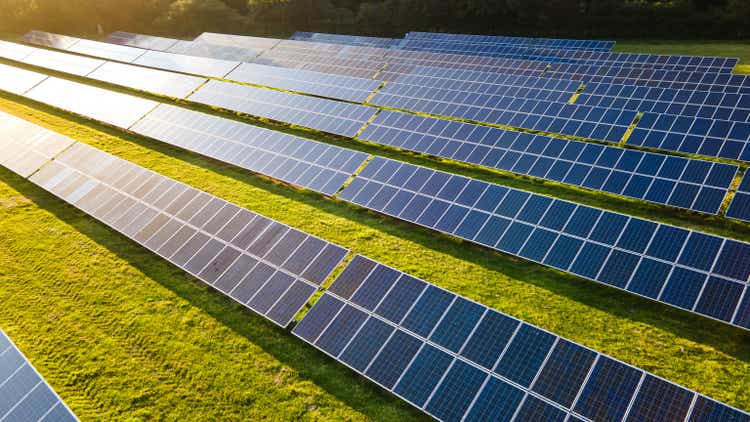
As mentioned in the bullets, the ALPS Clean Energy ETF (NYSEARCA:ACES) has significantly outperformed the broad S&P500 over the past three years (see graphic below). But that is looking backward, what about the future? I would argue that the future of clean energy continues to be very bright. Across the planet, and now here in the United States, government policy to adopt and accelerate the clean energy transition is a strong and very positive tailwind for the sector going forward. Today, I’ll take a close look at the ACES ETF to see if it might be worth an allocation of capital within your portfolio.
Investment Thesis
In a previous Seeking Alpha article on EV and battery maker BYD (OTCPK:BYDDY)(OTCPK:BYDDF), I reported on how governmental policy in China has been incentivizing EV adoption through implementation of its “Three Year Blue-Sky Action Plan” (see BYD Continues Making Huge Progress In Electric Buses (and Passenger EVs Too).
With the Biden administration’s ability to pass Clean Energy Legislation (or the so-called “Inflation Reduction Act”) through Congress, the U.S. has now joined the clean energy party in a serious way. The act allows up to $7,500 in tax credits for new EVs and $4,000 for used EVs. Those EV incentives, combined with the $7.5 billion for building out a national EV charging network contained in the bi-partisan Infrastructure Act, should certainly promote and accelerate the adoption of EVs in America and the timing was perfect: these subsidies come just as many domestic EV makers are set to roll out a plethora of new EVs to address a variety of markets – including trucks. Note that Bloomberg recently reported that by the year 2030, 50%+ of new vehicle sales in the US are now expected to be EVs.
Meantime, the vast majority of new electric power generation capacity continues to come from solar & wind (70% in 2021):
EIA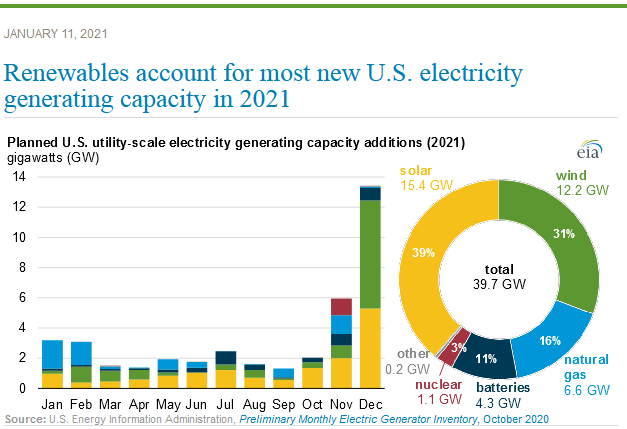
As I pointed out in my recent article on NuScale Power (SMR), there is a reason U.S. utility company CEOs continue to build out solar & wind capacity as opposed to nuclear or coal: they are cheaper, can be completed on time and on budget, and don’t have any of the nasty radioactive and heavy-metal laced coal fly-ash wastes to deal with. See NuScale: Is It Finally Time For Small Module Nuclear Reactors?.
Bottom line: governmental and fundamental support for clean energy is so strong it is a very positive tailwind for the clean energy sector. So let’s take a closer look at the ACES ETF to see how it has positioned investors for success going forward.
Top-10 Holdings
The top-10 holdings in the ACES ETF are shown below and equate to what I consider to be a relatively concentrated 51.5% of the entire portfolio:
ALPS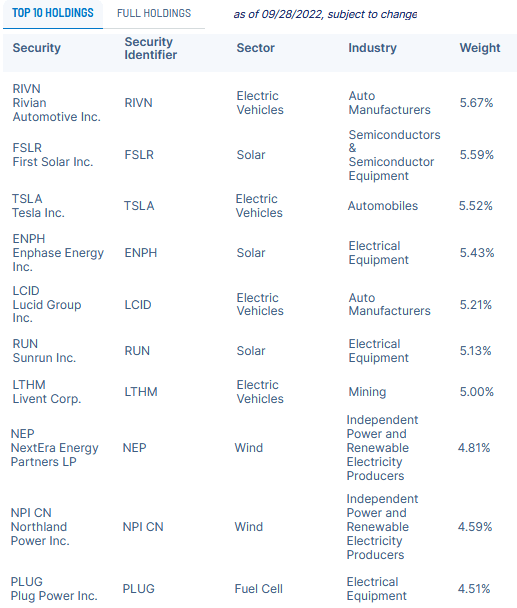
While the portfolio is rather heavily tilted toward the top-10 holdings, note that the allocation among the top-10 is nicely spread-out, with no holding equating to more than 5.7% of the fund.
The #1 holding with a 5.7% weight is EV maker Rivian (RIVN). Rivian makes five-passenger trucks and SUVs and is collaborating with Amazon (AMZN) on Delivery Vans. While Rivian has been making great progress and revenue has been rising, the company is still losing money. However, RIVN still expects to manufacture 25,000 vehicles this year, and last month, Seeking Alpha reported that recent filings showed that famed investors Ray Dalio and David Einhorn had taken stakes in the company.
First Solar (FSLR) is the #2 holding with a 5.6% stake. The US-based global provider of solar solutions is up 41% over the past year and has pledged $1.2 billion in U.S. expansion due to the Biden administration’s clean energy bill.
Enphase Energy (ENPH) has a 5.4% weight and just under Tesla (TSLA) as the #4 holding. ENPH stock is up a whopping 88% over the past year as it continues to ramp-up revenue and earnings due to its popular microinverters and associated networking and software technology.
The #8 holding with a 4.8% weight is NextEra Energy Partners (NEP), the Florida-based clean energy LP of NextEra (NEE) – the largest utility company in the United States. NEP currently yields 4% and trades with a forward P/E of 21.5x.
The #9 holding is Canada-based Northland Power Inc. (NPI:CA). NPI is a wind energy specialist and for more information consider reading Northland Power: Still Positive, by Seeking Alpha contributor Mare Evidence Lab. NPI is flat over the past year.
As one might expect, the overall portfolio is heavily weighted toward EVs, solar, and wind:
ALPS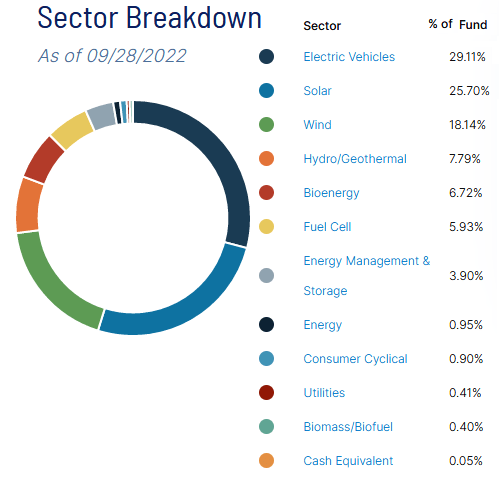
Performance
The performance of the ALPS ETF since inception is shown below:
As mentioned earlier, and although the fund hasn’t been around long enough to establish a long-term track record, the 19.45% average annual return is quite impressive in my opinion – especially given the wicked bear market of 2022.
However, there is a better clean energy ETF in my opinion: the First Trust Nasdaq Clean Edge ETF (QCLN), which has been a clear performance leader in the clean energy ETF space – delivering three-year returns almost double that of the ACES ETF:
QCLN has a 0.58% expense ratio and has a higher concentration in EV makers Rivian and Tesla as well as lithium producer Albemarle (ALB), all of which have an 8.5%+ weighting.
QCLN has been around much longer than the ACES ETF and has a very strong 10-year average annual return of 22.4%.
Risks
Supply chain risks and supply shortages – especially for critical battery materials like lithium – could slow the clean energy revolution. That is one reason I prefer QCLN: its large stake in Albemarle is a key strategic differentiator with ACES and would likely benefit if there was a big rise in lithium prices due to supply constraints.
Summary & Conclusion
The ACES ETF has a fine performance track record and an attractive portfolio of EV and solar & wind focused companies. It has been outperforming the S&P500 over the past few years and will likely continue to do so based on strong U.S. legislation designed to accelerate adoption of clean technology. That said, the QCLN has a much stronger performance track record and, in my opinion, holds a superior portfolio. If you own ACES, I rate it a HOLD. If you are an investor looking for a diversified clean energy ETF, I suggest you take a close look at the QCLN ETF, which I rate a BUY.


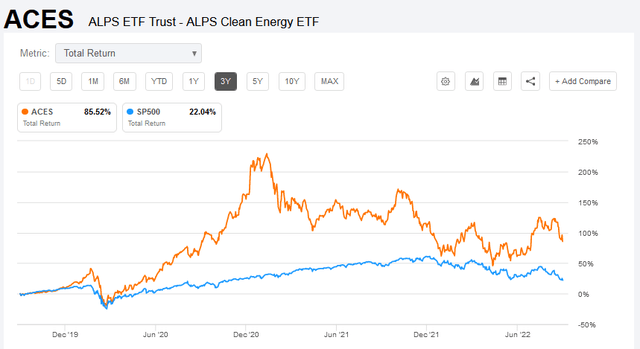
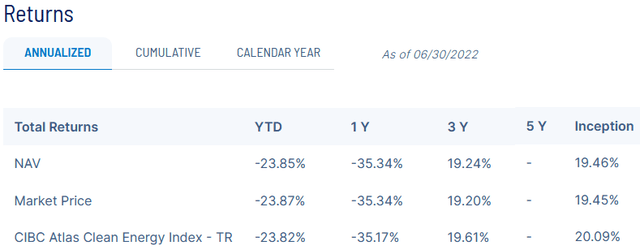
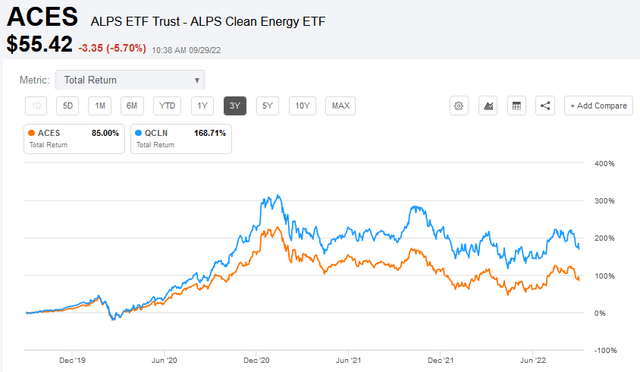
Be the first to comment